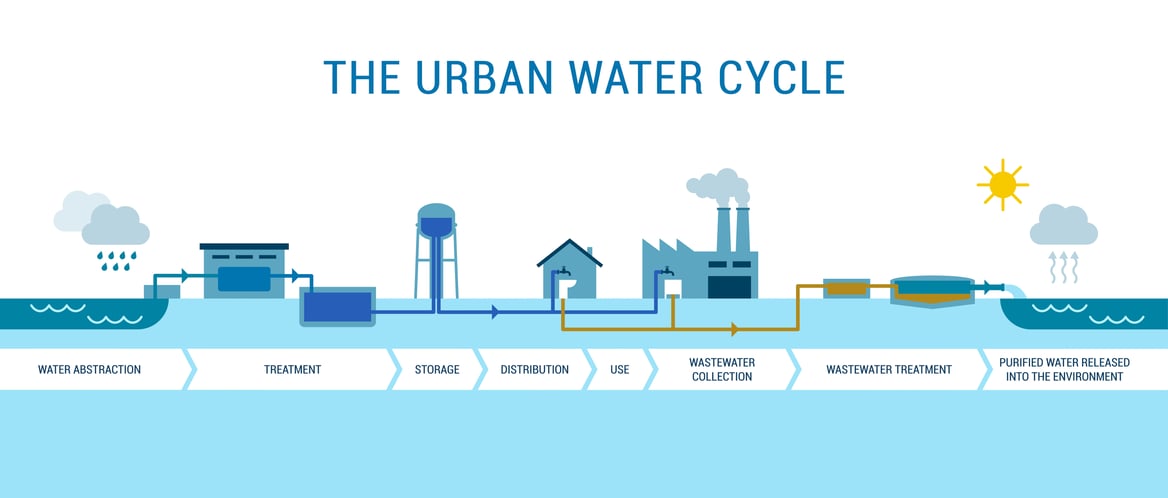Where does your water disappear to after it supplies your nightly dishwashing frenzy or sunrise concert in the shower? If all contaminated water went straight back into freshwater sources, downstream wildlife and public health would suffer greatly. Fortunately, we have an extensive wastewater treatment facilityies (WWTF) to prevent such disasters. The downside is that this process requires significant energy, but creative efficiencies and conscientious water use reduce the energy consumption of your WWTF.
Underground collection pipes round up everything that goes down the drain—from shower water to laundry leftovers to sewage—and channel it towards the nearest WWTF. The first stop is a series of screens and sand filters that remove large debris like paper, plastic, and metal. The largest objects are removed first to ensure smooth sailing for the rest of the treatment process, preventing clogs in the equipment. Settling tanks also appear early in the process, allowing solids to settle on the bottom of a basin or float to the top. Sludge is removed and disposed of separately while the water moves on.
At this point the water might appear clean to the human eye, but there are still biological pollutants hiding beyond sight. It is jam-packed with nitrogen and phosphorus, nutrients that could overload the river and produce algal blooms. Swimming in murky green water may be minorly inconvenient for people, but such blooms are deadly for aquatic animals like trout, who cannot breathe in algae-choked water. To prevent excess nutrients from entering the river, wastewater is heated and pumped with oxygen and bacteria. This bacterial jacuzzi promotes rapid pollutant digestion.

Wastewater treatment plays a vital role in the urban water cycle as it protects the people, aquatic life, and wildlife downstream that rely on freshwater sources.
Large volumes of new microbes can overwhelm the river ecosystem’s natural defenses, making animal populations decline and overall ecosystem health suffer. That’s why wastewater is disinfected with chlorine and UV light. (You may have done the same thing when camping, using chlorine tablets or a UV stick to purify stream water for your morning coffee.) This effectively kills parasites, bacteria, and viruses.
At this stage, the water is too hot to dump into the river. When it enters the facility, it’s usually around 50 degrees fahrenheit, and by now, it’s up to 95 degrees fahrenheit. The Avon facility boasts a heat recovery system that utilizes the heat-energy to warm the recreation center's swimming pools. This process cools the treated water, protecting the Eagle River’s natural temperatures.
After 8-16 hours, what was once wastewater is now 90% free of pollutants, 85% free of biological oxygen demand, and up to 99% free of coliform bacteria—but it took a lot of energy to get there. Wastewater treatment facilities deal with a lot of water: over 55,000 people call Eagle County home, and the average person uses anywhere from 80-100 gallons of water in a single day. Reduce your personal water footprint by turning off the faucet when shaving and brushing your teeth, and by running full loads of laundry or dishes. Doing so will ease the burden on your WWTF and increase its energy efficiency.
Where your water goes after you flush it down the drain is not such a mystery after all. Following a thorough treatment journey, that same water is returned to rivers that are rich with diverse wildlife. Thanks to thorough cleaning and cooling, humans can recreate knowing they are safe from salmonella, cholera, and E. coli, and wildlife can enjoy the uninterrupted diversity of microbes in the river. Eventually, your water may feed other faucets. Practicing mindful water use is an impactful way to reduce energy consumption and care for all of your downstream neighbors.
Lucy Trosper is a lead naturalist at Walking Mountains Science Center. She is passionate about the conservation of water so much so that she rarely showers.







